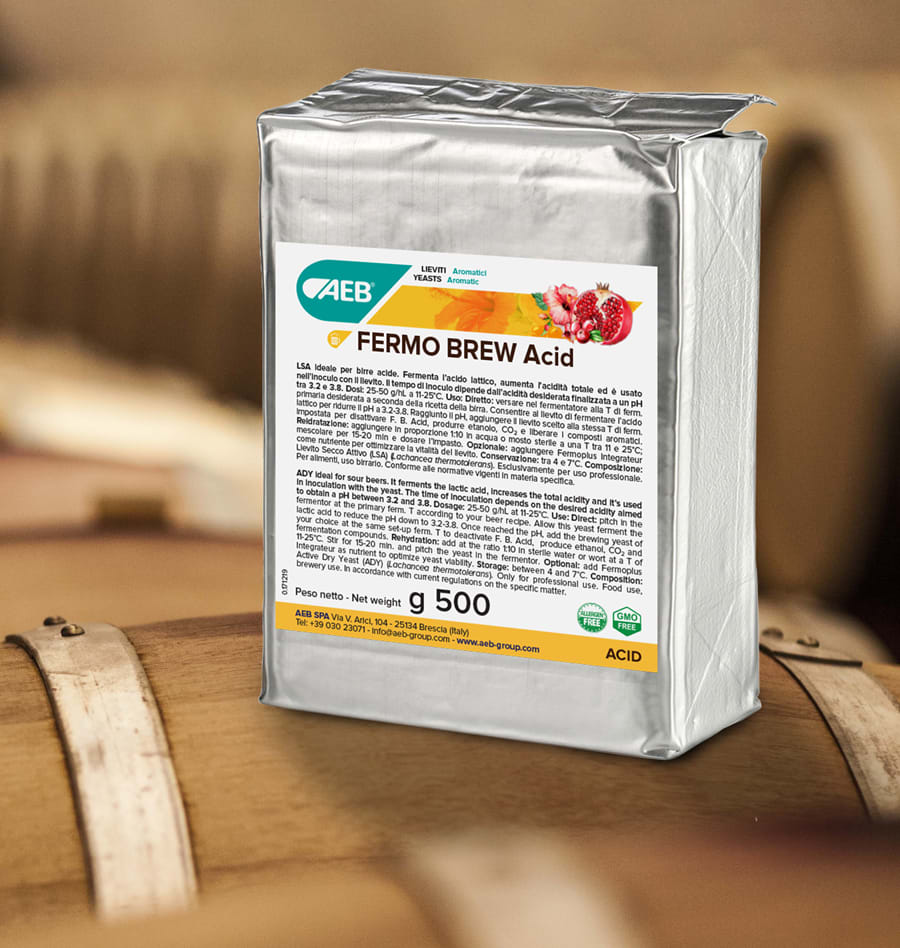DO YOU WANT TO BREW SOUR BEER? FERMO BREW ACID WILL HELP YOU BREW IT BETTER!
FERMO Brew Acid is the perfect solution for brewing exciting & distinctive sour beers, without the risk of cross-contamination
Sour beers have a long and rich history. In fact, when beer brewing began hundreds of years ago many beers were sour, as they contained naturally occurring bacteria which gave the beverage its distinctive sour taste. Each variety is intrinsically linked to the places where these beers were born, from the Belgian Lambic and Flanders Red Ale, to the German Gose and Berliner Weisse, amongst other signature European styles.
Traditionally, these beers are brewed through the spontaneous fermentation of lactic acid bacteria, Lactobacillus and Pediococcus, and the intricate alteration by other microorganisms such as Saccharomyces and Brettanomyces. These play a specific role in creating the diverse, complex flavour profiles of sour beers.
THE REDISCOVERY OF SOUR BEERS
FERMO BREW ACID: YEAST SPECIFICALLY FOR SOURS
WHAT ARE THE ADVANTAGES OF USING FERMO BREW ACID?
Not only can you produce sour beers in a short period of time with FERMO Brew Acid but there are also a whole host of benefits and advantages:
-
01It is very easy to use and should be treated just like a conventional active dry yeast. Just make sure you continue to measure the pH levels to monitor the acidification throughout the fermentation process.
-
02It drastically reduces the risk of cross-contamination due to its nature, which is neither a beer spoilage bacteria nor Brett strain. It therefore doesn’t require dedicated brewing equipment or specific sanitisation routines.
-
03Any residual presence of presence Fermo Brew Acid on the equipment will not be able to grow with the presence of conventional brewing yeasts (S. cerevisiae), so future batches won’t be contaminated.
-
04It allows easy pH management. With FERMO Brew Acid the pH drops gradually, making it easier to monitor pH levels and pinpoint the right time to add the sequent brewing yeast’s pitching.
-
05It ferments in a wide temperature range, i.e. 11 to 25°C, without producing a pungent sour character.
TIPS FOR USE
Being easy to use is a key benefit of FERMO Brew Acid, as highlighted previously. After the wort production, the beer can be pitched with nutrients provided by Fermoplus Fruity or Fermoplus Fragrance if desired.
Initially, fermentation won’t be very intense, so we advise monitoring the process by measuring the pH drop. Once the pH level is higher than 0.3 from the desired pH, the second strain can be pitched to stop the acidification activity and complete the further alcoholic fermentation. For instance, if you desired a final pH of 3.5, the ideal level for the sequent pitching of brewing yeast of your choice would be at a pH of 3.8.
Other benefits by using FERMO Brew Acid is the reduction of brewing costs since there is no need for expensive acidified malt in the mash neither any addition of lactic acid to the wort kettle nor the use of mixed microflora (i.e. beer spoilage bacteria and yeasts) during the beer fermentation.
HIGH VERSATILITY FOR THE PRODUCTION OF A WIDE RANGE OF SOUR BEERS
Whatever beer style is desired, FERMO Brew Acid ensures a low final pH (around 3.5), which guarantees pleasant sourness in harmony with other flavour attributes and excellent drinkability. The production of acidity and the decrease in pH are a result of the concentration of simple sugars in the wort, which are normally very low. If the aim is to achieve a lower pH, the addition of dextrose or fructose to the wort could be considered to supply more substrate, which will then be transformed into lactic acid.
FERMO Brew Acid offers brewers plenty of opportunity for customisation: from inoculation with conventional brewing yeasts (S. cerevisiae) to maturation in wooden barrels and the use of fruits or other flavouring ingredients. Its combination with various brewing yeasts allows you to brew any sour beer variants, such as American-style Sour Ales. Lactic acid bacteria are sensitive to the antiseptic properties of hops which limit the amount of hops used, resulting in potential contamination risks. FERMO Brew Acid, on the other hand, is not sensitive to the antiseptic effects of hops, leading to acidic fermentation in even heavily hop forward worts or dry-hopped beers.
Last but not least, FERMO Brew Acid can develop varied fermentative aromas and fruitiness in taste and a complex & pleasant aftertaste, which can be controlled and adapted through the fermentation temperature. At 18°C FERMO Brew Acid will evolve towards citrus notes of grapefruit, while at higher temperatures (25°C), the profile will be more orientated towards tropical fruit notes such as mango and papaya.
-
Beer styles
Berliner-Style Weisse
Sour Saison
American-Style Sour Ales
(e.g. Sour IPA)Belgian-Style Flanders Oud Bruin or Oud Red Ale
Belgian-Style Fruit Lambic
Belgian-Style Gueuze
Contemporary-Style Gose
Ideal sequential pitching in combinations
with FERMO Brew Acid


 Hungary
Hungary
 United Kingdom
United Kingdom







